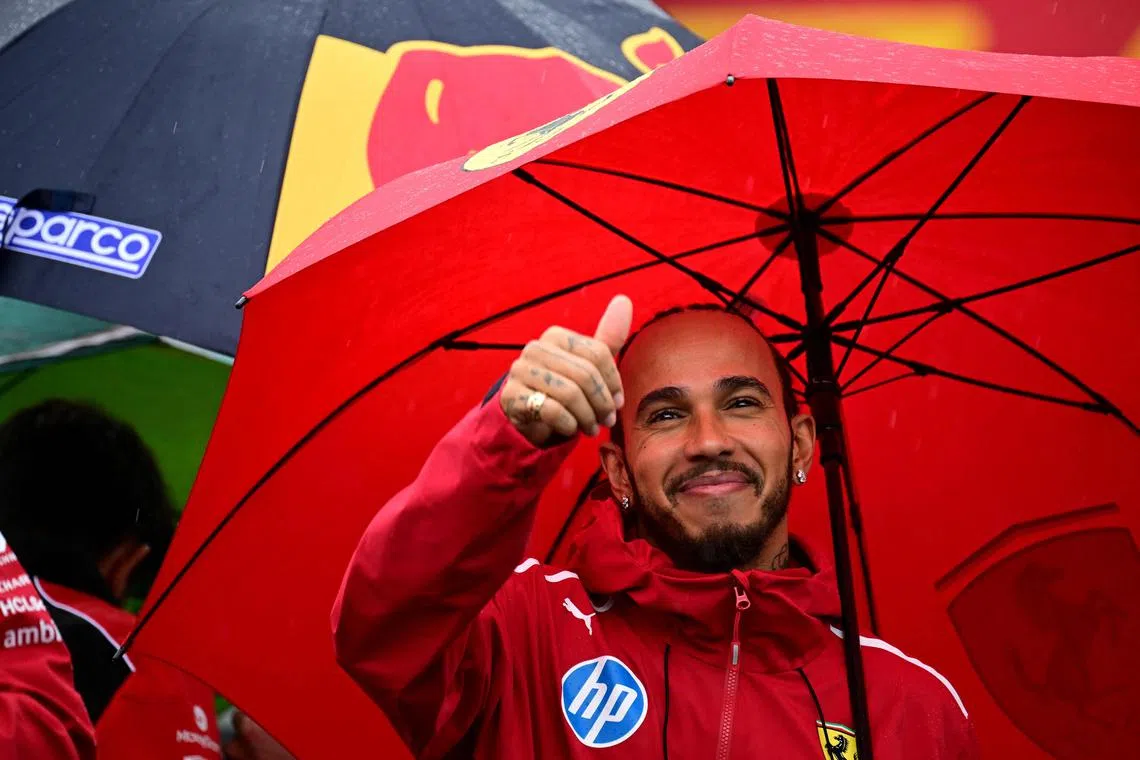F1 the sport should be more like F1 the movie
Sign up now: Get ST's newsletters delivered to your inbox

Ferrari's Lewis Hamilton waves to fans during the drivers parade before the British Grand Prix.
PHOTO: AFP
Follow topic:
NEW YORK – When the filmmakers behind the movie F1 decided to make the most authentic motor racing film ever seen, they reached out to Lewis Hamilton.
The seven-time Formula One world champion signed on as a producer, and – with his input – the breathtaking, hyper-realistic racing has made the film a hit.
However, F1’s commitment to authenticity is not absolute. For years, Hamilton has been critical of Formula One over its lack of diversity and gender equality.
Rather than depict that reality, he pushed the producers to hire a cast that reflects “how F1 should be in the future, or should be now”, he explained in 2023, when the film was still in production.
He got his wish.
APX GP, the fictional team at the heart of F1, features prominent roles for women and under-represented groups (alongside Brad Pitt). By any measure, it is far more diverse than any actual team racing in 2025.
So, what about the real-life sport? What is stopping it from reflecting the vision audiences are seeing in theatres – and how fast can it catch up? The current lack of diversity is quantifiable.
In the history of Formula One, there has been only one black driver: Hamilton. And the chances that a black person is working in a different role in a racing team are similarly dismal.
According to a 2021 report, less than 1 per cent of the Formula One workforce came from black or other ethnic minority backgrounds.
Women have faced their own struggles in the sport. As recently as 2022, women who worked in the series were paid, on average, 20 per cent less than their male counterparts, and comprised only around a third of the workforce. Meanwhile, the last female driver to score points in a Formula One race, Lella Lombardi, did so in 1975.
The causes of Formula One’s disparities are complex and varied. But like other motor sports, much of the problem comes down to the cost of participation.
Go-karting is the starting point for most racing careers, and it is not cheap. In 2024, the Washington Post reported that parents can pay as much as US$10,000 (S$12,797) to participate in elite-level karting competitions scouted by Formula One.
The children who show talent and – this part is key – can afford it, advance to the next rung of competition, F4, which might cost as much as US$325,000 for a year of racing. The next two steps – F2 and F3 – require millions.
In theory, an aspiring teenager can hustle for sponsors to pay these costs. In reality, though, family wealth and pre-existing connections to Formula One are all but necessary prerequisites to getting on the ladder.
Those who battle the financial odds often find themselves running up against other institutional barriers.
For example, a 2023 report on women in motor sports found that sponsors are reluctant to invest in promising female drivers because there has not been a record of other women succeeding behind the wheel.
In earlier decades, Formula One could prosper on the basis of exciting races and an atmosphere of (mostly) European exclusivity. But in recent years, fans – especially new fans – want deeper insights into the personalities and storylines that define a season.
Social media provides that content, as do documentaries like Netflix’s hit series Drive to Survive. But to really engage fans and make the sport more relatable, Formula One needs a cast as diverse as the F1 movie it helped make.
To its credit, the sport is steering in the right direction.
In 2024, it adopted a new diversity and inclusion charter. It is also making a concerted effort to fund the development of women drivers, and to raise their visibility. Perhaps most importantly, it has established engineering scholarships to help students from under-represented backgrounds establish careers in the sport.
None of these efforts will, on their own, diversify a sport rooted in European wealth and an image of exclusivity. Doing so will require that Formula One view diversity as a long-term commitment, not just a public relations gesture as it has in the past.
But if the series sticks with it, it can make one of the world’s most elite sports more welcoming and – if the success of the F1 movie is any indication – even more popular. BLOOMBERG

